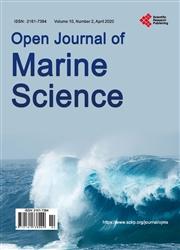Research on Growth Characteristics of Green-Tide-Forming Green Algae under Stress Conditions
引用次数: 0
Abstract
The cytological characteristics of major green-tide-forming green algae Ulva prolifera collected from Yellow Sea were studied through cutting segments, long time low temperature or dark treatments. After being dried in the shade and preserved at -20°C for 30 days, the U. prolifera was cultured at 4°C in sterilized seawater under 40 μmol photons m-2·s-1 light intensity for 120 days, results indicated that the plastid of U. prolifera continuously shrank with the extension of treatment, and most cells turned white and died, only a small amount of cells still contained a few of visible inclusions at the 120d of treatment. Then those samples were transferred to 20°C and 40 μmol photons m-2·s-1 condition for recovery cultivation, after about 10 days, some recovery cells were observed in the thallus, and those cells developed to young thallus gradually and released germ cells almost in the same time. After about 60 days of recovery cultivation, the newly-grown green thallus broke through the original dead thallus, and the germ cells also grew to new individual thallus. Before dark treatment, the U. prolifera cells were filled with plastid, contained visible starch grain and discernible cell outlines, while after 120 days of dark treatment, the plastid shrank and degraded together with the disappearance of cell inclusions, and the cell outlines also blurred, then those samples were transferred to optimal culture conditions at 20°C in 40 μmol photons m-2·s-1 light intensity, and 15 days later, newly-grown cells appeared on the almost dead thallus, these cells divided continuously and grew to young thallus, and those newly-grown thallus also generated active germ cells, which developed to new thallus that cytologically identical to the original thallus. Observation of chopped tissue of U. prolifera cultivated at 20°C, 40 μmol m-2·s-1 showed that the morphological upper part cells turned to germ cells first, those germ cells including gametophyte and sporophyte, which released later and grew to new individual thallus. These findings provided cytological evidences for how U. prolifera live through stress conditions such as low temperature, darkness, and also useful for understanding the mechanism of the occurrence of green tide.胁迫条件下绿潮绿藻生长特性的研究
采用切段、长时间低温或暗处理等方法,对采自黄海的主要绿潮绿藻Ulva prolifera的细胞学特征进行了研究。在阴凉处干燥并在-20°C下保存30天后,在4°C的无菌海水中,在40μmol光子m-2·s-1光照强度下培养120天,在处理的120d,只有少量的细胞仍然含有少量可见的夹杂物。然后将这些样品转移到20°C和40μmol光子m-2·s-1的条件下进行回收培养,大约10天后,在铊中观察到一些回收细胞,这些细胞逐渐发育成年轻的铊,并几乎同时释放出生殖细胞。经过大约60天的恢复培养,新生长的绿色铊突破了原来的死铊,生殖细胞也生长成新的单个铊。在暗处理之前,增殖乳杆菌细胞充满质体,含有可见的淀粉颗粒和可辨别的细胞轮廓,而在暗处理120天后,质体收缩和降解,细胞内含物消失,细胞轮廓也变得模糊,然后将这些样品转移到20°C、40μmol光子m-2·s-1光强度的最佳培养条件下,15天后,在几乎死亡的铊上出现新生长的细胞,这些细胞不断分裂并生长为年轻的铊,这些新生长的铊也产生了活的生殖细胞,其发育成在细胞学上与原始铊相同的新铊。对在20°C、40μmol m-2·s-1培养条件下生长的浒苔切片组织的观察表明,形态上部细胞首先转化为生殖细胞,这些生殖细胞包括配子体和孢子体,随后释放并生长为新的单个铊。这些发现为浒苔如何在低温、黑暗等胁迫条件下生存提供了细胞学证据,也有助于理解绿潮发生的机制。
本文章由计算机程序翻译,如有差异,请以英文原文为准。
求助全文
约1分钟内获得全文
求助全文

 求助内容:
求助内容: 应助结果提醒方式:
应助结果提醒方式:


